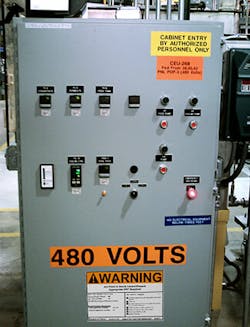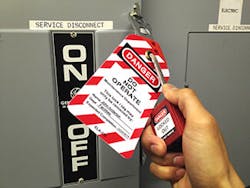Types of Electrical Safety Signs and Their Requirements
Electrical safety is a major problem in modern workplaces. Each year, OSHA produces a list of its 10 most frequently cited violations. General electrical safety requirements show up on that list year after year. While electrical safety involves many different elements, safety signs are often overlooked.
Electrical safety signs communicate important information to workers. They can also be one of the most efficient tools in a facility manager’s toolkit. They’re also required by a variety of laws and standards.
Safety Sign Requirements
OSHA’s rules on electrical safety in the workplace include a clear call for electrical safety signage. The rules in 29 CFR 1910.335(b) require signs to be used “where necessary to warn employees about electrical hazards.” Which hazards are covered here? All those “which could cause injury due to electric shock, burns, or failure of electric equipment parts.”
OSHA’s requirements for workplaces aren’t the only rules that need to be followed. The National Electrical Code (NEC) is published by the National Fire Protection Association (NFPA) and is part of the legal requirements for construction in most jurisdictions in the United States. The NEC has its own requirements for warning signs and other identification systems.
Once the legal requirements have been met, it’s a good idea to follow expert recommendations for safety. For electrical safety in the workplace, the leading industry standard is also written by the NFPA and is published as NFPA 70E. This standard covers recommended practices for performing work, training employees, and determining appropriate equipment. It also includes its own requirements for electrical safety signage.
Types of Electrical Safety Signs
Just as there are many kinds of hazards, there are also many kinds of signs to inform workers about those hazards. These are some of the more common types.
Voltage Marker and Basic Equipment Information
Many signs and labels take an extremely simple form. Voltage markers may consist only of a narrow orange label, with the nominal voltage of a piece of equipment marked in bold, black text. Additional details may be appropriate as well. These labels can also identify connected equipment or the control location. This type of label can serve as a core element of safety by quickly identifying systems.
Arc Flash Labels
Complex and dangerous hazards, like arc flash, need a more detailed approach. OSHA requires informative signs to warn workers about hazards in general, and the NEC requires specific warnings for arc flash hazards. The NFPA 70E standard goes further and gives detailed requirements for the information on arc flash labels.
These detailed electrical safety signs must show certain information. The nominal system voltage and the arc flash boundary offer the first steps for general safety. Arc flash labels also need to help a qualified worker choose the right personal protective equipment (PPE) for safe work.
Electrical Clearance Signs
Even when arc flash is not likely, a safe clearance around electrical equipment may be needed. For example, OSHA requires a clear working area near most electrical panels and similar controls. This rule, in 29 CFR 1910.303(g)(1), generally requires clear space for at least 36 inches in front of panels. The clear area should be at least 30 inches wide, or the full width of the equipment (if wider than 30 inches).
Post a sign on the panel that shows the amount of space to be kept free. These clearance signs help ensure that all workers, from electricians to janitors, respect the safe boundary. Productive floor marking can also provide an effective visual aid in these cases by clearly showing the clearance area.
Safe Procedures
Where step-by-step procedures must be followed, post the required steps. It’s an easy and effective way to remind workers of the appropriate work process. This can be especially important with powerful electrical equipment, which may need to be locked and tagged out for maintenance.
For a lockout/tagout (LO/TO) procedure to be effective, it must be customized to each piece of equipment. Don’t just hope that workers will remember every step of every machine. Place signs and labels to provide a helpful reminder, of when and where those steps are needed. For more information about this process, download our guide to Lockout/Tagout.
Maintenance procedures are not the only ones that can be posted on equipment to improve safety and efficiency. Even basic startup and shut-down steps can be helpful. Ordinary operating instructions and steps for adjusting the equipment may be included, too.
Visual Solutions for Electrical Safety
Most of these signs need to be customized for each facility, or even for each piece of equipment. It’s important to think about the design of a safety sign or label before ordering it or printing it on-site. Fortunately, visual communication has been a major topic in the field of workplace safety for decades.
Some basic tips for OSHA-compliant safety signs can be easily applied to electrical safety signage. Where signs warn workers about a potential injury, they should follow OSHA’s standards for hazard prevention signs in 29 CFR 1910.145. This is an old rule, though. As a more up-to-date alternative, OSHA allows facilities to follow recommendations from the American National Standards Institute (ANSI). These recommendations form the signage standard ANSI Z535.
Under both systems, signs should use clear phrasing to communicate quickly and reliably. Signs should be clearly visible and legible to the workers who need that information. Using a standardized approach like ANSI Z535 also lets the sign’s colors and signal words communicate the urgency of the sign’s information. A “Caution” sign is for relatively minor hazards and warnings, while a “Danger” sign is for a major hazard, posing a risk of death or serious injury. For a more in-depth approach to standardized signs in your workplace, download our free OSHA safety signs guide.


